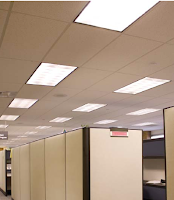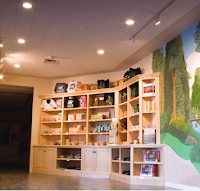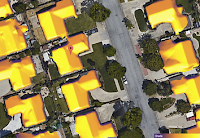LEDs are durable and save energy. Now researchers have found a way to make LED lamps even more compact while supplying more light than commercially available models. The key to success: transistors made of the semiconductor material gallium nitride.
At Aztec Electrical we can help you design, install, and maintain LEDs to reduce your lighting expenses. Because we are a Trade Ally with the Oregon Energy Trust, we can also help you receive cash rebates and/or incentives for your home or business lighting project. Call us today at 541.245-8560. #lightingdesign
Incandescent light bulbs are now banned in the EU, while energy-saving lamps remain a bone of contention. In 2016, it will be lights out for halogen bulbs over 10 watts as well. LEDs (light-emitting diodes) therefore have the best chance of becoming the light source of the future. Experts reckon that LED retrofit lamps for use in standard bulb fittings will overtake traditional energy-saving bulbs for the first time from 2015. By 2020 it is predicted that LEDs will have captured between 88 and 90 percent of the lighting market. The tiny diodes offer a whole host of advantages as the most environmentally friendly source of light – they contain no harmful substances, consume less energy and, with a lifetime of between 15,000 and 30,000 hours, last longer than conventional light sources. They also work at full brightness as soon as you flick the switch.

Aztec Electrical provides professional electricians in Southern Oregon to homes, businesses, and on electrical contracting projects. Our headquarters is in Medford. We are a trade ally contractor with the Energy Trust of Oregon. We specialize in lighting design renovations, which have two significant benefits: 1) lower energy consumption and 2) lower energy costs.
Thursday, August 27, 2015
Wednesday, August 26, 2015
New lighting technology improved with cheaper manufacturing
New
research at Rutgers University has shown how to slash the cost of highly
efficient light emitting diodes (#LED) and significantly reduce
lighting’s energy requirements. The energy savings, however, will likely
be eroded as people find new uses for the inexpensive lights.
LED lights use just 10 percent of the energy of incandescent lights and less than half the energy of today’s compact fluorescent (CFL) bulbs. An LED that uses 6 watts of electricity, for example, produces the same amount of light as a 14-watt CFL bulb or a 60-watt incandescent bulb. According to the U.S. Department of Energy, electricity used for artificial lighting in the U.S. could be cut nearly in half by 2030 through the adoption of high efficiency LEDs.
LED lights use just 10 percent of the energy of incandescent lights and less than half the energy of today’s compact fluorescent (CFL) bulbs. An LED that uses 6 watts of electricity, for example, produces the same amount of light as a 14-watt CFL bulb or a 60-watt incandescent bulb. According to the U.S. Department of Energy, electricity used for artificial lighting in the U.S. could be cut nearly in half by 2030 through the adoption of high efficiency LEDs.
The
lights are commercially available today but haven’t been widely adopted
because they are more expensive than either CFLs or incandescents. The
high cost of LEDs is due in part to their reliance on rare earth
elements for their phosphors, materials that shift the blue light
emitted by most LEDs into a broad spectrum of white light.
A
new class of phosphors made from earth-abundant materials could slash
the cost of LEDs by as much as 90 percent according to their developers.
The
work has been driven by a dramatic increase in the cost of rare earth
elements -- by as much as 1600 percent over the past decade -- due to
increased demand and decreased exportation of the materials from China,
which has historically produced more than 90 percent of the world’s rare
earth elements.
A
2010 study looked at lighting use around the world for the past 300
years as lighting technology improved from whale oil lamps to gas and
kerosene lamps to electric incandescent bulbs. The study, conducted by
researchers at Sandia National Laboratories in Albuquerque, New Mexico found a direct relationship between decreased cost and increased consumption.
Looking
at the current transition from incandescent lights to CFLs and
ultimately LEDs, the authors concluded "there is a massive potential for
growth in the consumption of light if new lighting technologies are
developed with higher luminous efficacies and lower cost of light."
Aztec Electrical has helped businesses and home owners reduce their lighting expenses. Call our office today to learn more about how you can use new lighting technology to your advantage.
Monday, August 24, 2015
LED Research: LED lighting enhances mood and environment
For as long as we can recall, #lightingdesign has focused its product placement, design, and marketing on fulfilling visual needs. In the more recent past, issues of sustainability and a need for more efficient energy sources has sparked a further interest in creating green lighting technologies, with LED technology of course at the forefront.
LED lighting technology has just bumped into an entirely new dimension of possibilities and benefits with the help of a study and other research in the field of human-centric lighting (HCL).
A recent study of Lighting Europe and the German Electrical and Electronic Manufacturer's Association (ZVEI) and A.T. Kearney led to surpurising findings regarding the mass potential of LED lighting technology in the field of HCL and mood lighting which promises to gain a significant portion of the global LED illumination market by 2020.
Human-centric #LED mood lighting enhances well-being in two distinct but related ways:
#1 it can be optimized to effectively stimulate the organism biologically which leads to improved cognitive performance, which already proves itself in various educational settings such as classrooms.
#2 LED-based human centric lighting can emotionally stimulate by creating emotionally appealing and stimulating atmospheres, leading to improved positive emotions.
Aztec Electrical is a leader in Rogue Valley for optimizing #lightingdesign in both the home and work environments. Call us today, 541-245-8560, to learn more about our services.
LED lighting technology has just bumped into an entirely new dimension of possibilities and benefits with the help of a study and other research in the field of human-centric lighting (HCL).
A recent study of Lighting Europe and the German Electrical and Electronic Manufacturer's Association (ZVEI) and A.T. Kearney led to surpurising findings regarding the mass potential of LED lighting technology in the field of HCL and mood lighting which promises to gain a significant portion of the global LED illumination market by 2020.
Human-centric #LED mood lighting enhances well-being in two distinct but related ways:
#1 it can be optimized to effectively stimulate the organism biologically which leads to improved cognitive performance, which already proves itself in various educational settings such as classrooms.
#2 LED-based human centric lighting can emotionally stimulate by creating emotionally appealing and stimulating atmospheres, leading to improved positive emotions.
Aztec Electrical is a leader in Rogue Valley for optimizing #lightingdesign in both the home and work environments. Call us today, 541-245-8560, to learn more about our services.
Monday, August 17, 2015
Project Sunroof: mapping the planet’s solar energy potential, one rooftop at a time
Google's Project Sunroof is helping homeowners map the solar energy potential power to their home.
The cost of solar power is at a record low. A typical solar home can save hundreds or even thousands of dollars per year on their electricity bill. But, as a volunteer with the Boston-based solar program Solarize Massachusetts and a solar homeowner myself, I’ve always been surprised at how many people I encounter who think that “my roof isn’t sunny enough for solar,” or “solar is just too expensive.” Certainly many of them are missing out on a chance to save money and be green.
Check out the blog for the project here.
The cost of solar power is at a record low. A typical solar home can save hundreds or even thousands of dollars per year on their electricity bill. But, as a volunteer with the Boston-based solar program Solarize Massachusetts and a solar homeowner myself, I’ve always been surprised at how many people I encounter who think that “my roof isn’t sunny enough for solar,” or “solar is just too expensive.” Certainly many of them are missing out on a chance to save money and be green.
Check out the blog for the project here.
Sunday, August 16, 2015
Lighting Design: California DMV in Sacramento goes LED
 |
| Pre Retrofit |
Task-ambient lighting provides an estimated 40 – 50% energy savings over current energy codes. It has the potential for 600 – 700 MW demand reduction statewide, and 2,000 – 3,000 GWh annually. It should provide an annual energy savings of about 15 – 25 cents per square foot of building space, meaning $300 million to $400 million annual energy savings for California. The simple payback is immediate to one year when used in new construction projects. It has a four- to seven-year simple payback in retrofit projects.
 |
| Post Retrofit |
- High-quality ambient and task lighting for an aesthetically pleasing office environment
- Energy-efficient LED task light components that can be customized to the individual workspace
- Optional personal occupancy sensor to control task lights
#electrician #lightingdesign
Wednesday, August 12, 2015
LED lighting makes all the difference in classrooms at one elementary school
How beneficial is LED lighting? At Cherokee Elementary
School in Scottsdale, Ariz., new-fangled LED lighting fixtures not only
save energy, they also prevent special education students with autism
from being bothered by fluorescent lighting. Researchers maintain that
individuals with autism are more vulnerable to the sub-visible flicker
of direct fluorescent lighting, which can cause headaches, eyestrain and
increased repetitive behavior.
Call Aztec Electrical today at (541) 245-8560 to learn more about using our #lightingdesign services in conjunction with rebates and incentives from the Energy Trust of Oregon.
In this pilot project, Scottsdale Unified School District replaced 69 2x4-foot fluorescent lighting troffers in four special education classrooms with 60 2x2-foot flat-panel LED fixtures from lighting manufacturer MaxLite. The install has the added benefit of energy savings.
The new lighitng used MLFP22D4535 2x2 Direct Lit Flat Panels. These panels each emit 3,850 lumens of brightness while using just 45 watts. The lumen power is far less than the 8,000 lumens the school’s previous fluorescent troffers offered, but those classrooms had been overly lit.
Source: adapted from material at the K12 TD web site.
#electrician #lightingdesign
Call Aztec Electrical today at (541) 245-8560 to learn more about using our #lightingdesign services in conjunction with rebates and incentives from the Energy Trust of Oregon.
In this pilot project, Scottsdale Unified School District replaced 69 2x4-foot fluorescent lighting troffers in four special education classrooms with 60 2x2-foot flat-panel LED fixtures from lighting manufacturer MaxLite. The install has the added benefit of energy savings.
The new lighitng used MLFP22D4535 2x2 Direct Lit Flat Panels. These panels each emit 3,850 lumens of brightness while using just 45 watts. The lumen power is far less than the 8,000 lumens the school’s previous fluorescent troffers offered, but those classrooms had been overly lit.
Source: adapted from material at the K12 TD web site.
#electrician #lightingdesign
Monday, August 10, 2015
Research: dimmable lights, done correctly, save energy
Call Aztec Electrical today at (541) 245-8560 to learn how our services can assist your project with new lighting technology.
We can assist you with understanding the available rebates and incentives to improve your lighting project ROI.
Our #electrical and #lightingdesign services include #ledlighting.
Recent studies estimate more than 800 million recessed downlights are in operation in the United States, split nearly equally between residential and commercial applications, with about 83% still using incandescent lamps. Inexpensive compact fluorescent lamp (CFL) downlights are commercially available, but most of these units are not dimmable, which is a desired attribute for many downlight applications. Therefore, energysaving CFLs often are overlooked in lieu of the functionality of incandescents.
Installation of LED downlights in retrofit and new construction situations is almost identical to typical incandescent or CFL recessed downlights. The exception is that many LED downlight housings can be in direct contact with insulation. Replacement scenarios are generally one-to-one in retrofit applications. Equipment costs range from $100 to $300 depending on the manufacturer and distributor, but costs may be offset by maintenance savings and utility rebates.
BENEFITS:
We can assist you with understanding the available rebates and incentives to improve your lighting project ROI.
Our #electrical and #lightingdesign services include #ledlighting.
Recent studies estimate more than 800 million recessed downlights are in operation in the United States, split nearly equally between residential and commercial applications, with about 83% still using incandescent lamps. Inexpensive compact fluorescent lamp (CFL) downlights are commercially available, but most of these units are not dimmable, which is a desired attribute for many downlight applications. Therefore, energysaving CFLs often are overlooked in lieu of the functionality of incandescents.
 |
Bidwell Mansion Visitor Center,
|
BENEFITS:
- The HALO LED recessed downlight is the first ENERGY STAR-rated LED downlight and exceeds the high efficacy requirements set by energy regulations
- High color rendering and warm white color temperature: 80CRI at 3045K
- Delivers light equivalent to many standard incandescent sources used in recessed downlight applications
- Dimmable to 15% of total light output with standard AC incandescent dimmers, 5% with low-end trim adjustment
Subscribe to:
Comments (Atom)





